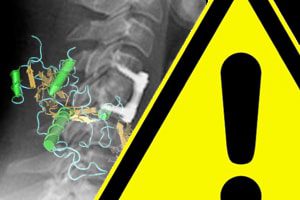
A recent study on the use of the controversial bone growth material known as bone morphogenetic protein (BMP) shows that its off-label use includes the application in pediatric spinal fusion surgeries. Nearly 10 percent of all pediatric spinal fusion surgeries employ the use of BMP, a means of promoting new bone growth at the site of […]
 A recent study on the use of the controversial bone growth material known as bone morphogenetic protein (BMP) shows that its off-label use includes the application in pediatric spinal fusion surgeries.
A recent study on the use of the controversial bone growth material known as bone morphogenetic protein (BMP) shows that its off-label use includes the application in pediatric spinal fusion surgeries.
Nearly 10 percent of all pediatric spinal fusion surgeries employ the use of BMP, a means of promoting new bone growth at the site of a surgery, according to new data from a study appearing in a recent edition of the Journal of the American Medical Association. Researchers from Hospital for Special Surgery in New York looked at data from more than 4,000 hospitals across the U.S. equipped to perform pediatric spinal fusion surgery and found that, of more than 8,000 procedures, 9.2 percent of those surgeries used BMP rather than using a traditional bone graft to promote new bone growth.
Medtronic, the manufacturers of the Infuse bone growth product that uses BMP, is facing federal scrutiny over its marketing of this new product for off-label means.
The company is also currently the focus of a federal investigation into the means by which BMP was approved for use in any type of surgery. Last week, the Senate Finance Committee announced that its initial investigation has focused on the instances in which Medtronic paid researchers to alter their findings in clinical trials that hid the potentially dangerous side effects of using BMP and that it crafted language to be used in speeches that promoted its use and in clinical trial data submitted to the Food and Drug Administration for its approval.
BMP is only approved in a very limited number of spinal fusion surgeries but Medtronic appears to have been promoting its use in numerous other surgical procedures, including surgeries on the neck and actively trying to keep any reports of adverse side effects from going public. Instead, the company actively promoted the experimental use of BMP in unapproved spinal fusion and neck surgeries, keeping data it had on some dangerous and potentially life-threatening side effects from going public.
Among the many side and adverse effects associated with the use of BMP is excessive bone growth. This can be extremely painful and if the surgery is performed in an unapproved location, that unwanted bone growth could lead to complications like a blocked airway and difficult breathing. Use of BMP has also been linked with side effects like wound dehiscence, spinal stenosis, and respiratory stenosis, according to the study performed by researchers at Hospital for Special Surgery.
The study found complication rates among the pediatric recipients of BMP to be about the same as adults, at 10 percent. BMP however, is not approved for any pediatric applications. Also, the study only reviewed complications experienced during hospitalization and most problems associated with BMP occur after a patient has left the hospital, meaning complication rates could be even higher.
Authors suggest stopping the use of BMP in pediatric spinal fusion or any other surgeries until data is presented that shows it to be safe and effective.


